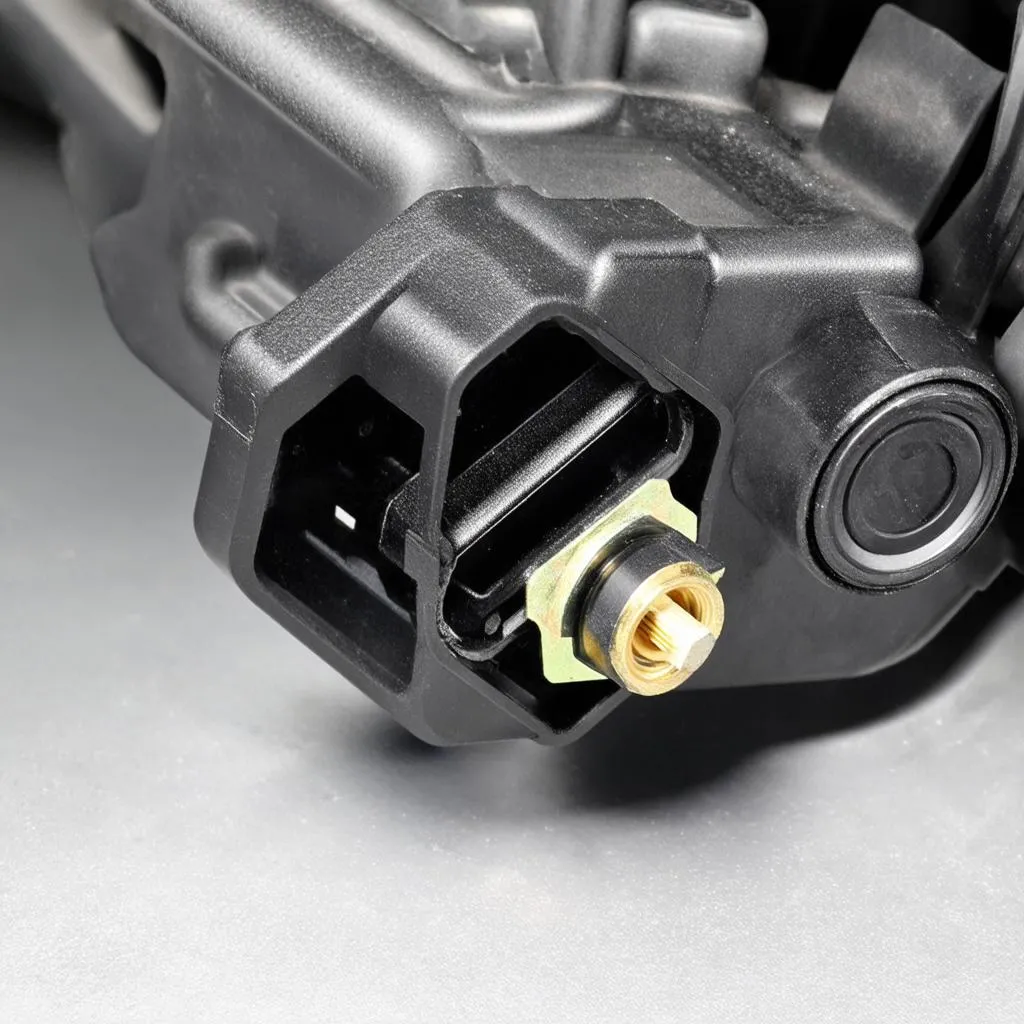Imagine this: you’re cruising down a scenic highway, windows down, enjoying the breeze, when suddenly, your Ford starts acting up. The engine stumbles, the check engine light blinks ominously, and a wave of worry washes over you. You pull over, heart pounding, and wonder what could be wrong. Later, a mechanic tells you it’s a P1120 code—a mysterious message from your car’s computer pointing towards the Throttle Position Sensor (TPS).
Don’t panic! This code, while daunting at first glance, is more common than you might think. Let’s break down this cryptic code, understand what it means for your Ford, and most importantly, how to get you back on the road.
What Does the Dreaded “Ford Obd Code P1120” Actually Mean?
In the intricate world of automotive mechanics, the P1120 code signals a potential issue with your vehicle’s Throttle Position Sensor (TPS). This small but mighty sensor acts like your car’s nervous system, relaying crucial information about how open or closed the throttle plate is to the Engine Control Module (ECM).
Think of it like this: the TPS is the messenger, the throttle plate is the mouth, and the ECM is the brain. When you press the gas pedal, you’re telling the throttle plate to open, allowing more air into the engine to increase speed. The TPS then relays this “message” to the ECM, which in turn, adjusts the fuel injection and ignition timing for optimal performance.
However, when the P1120 code rears its head, it means this communication chain has been disrupted. The ECM is receiving inconsistent or illogical signals from the TPS, indicating a potential malfunction.
Decoding the Symptoms: What Happens When P1120 Strikes?
Just like a cryptic message, the P1120 code manifests in various ways. Here are some telltale signs that this code might be plaguing your Ford:
- Hesitation or Stumbling Engine: This is one of the most common symptoms of a faulty TPS. Your engine might hesitate or stumble, especially when accelerating.
- Rough Idle: Does your engine sound like it’s about to stall when idling? A faulty TPS could be the culprit, disrupting the delicate air-fuel balance at idle.
- Reduced Fuel Economy: When the TPS malfunctions, it can send inaccurate data to the ECM, leading to inefficient fuel consumption and a lighter wallet.
- Illuminated Check Engine Light: This is your car’s way of saying, “Hey, something’s not right!” While it could be due to several reasons, the P1120 code is a strong contender.
- Sudden Surges in Acceleration: In some cases, a faulty TPS can send erratic signals, causing your Ford to accelerate unexpectedly even without pressing the gas pedal—a potentially dangerous situation.
What Causes This Communication Breakdown in Your Ford?
Now that we’ve explored the symptoms, let’s delve into the root causes of this communication breakdown between the TPS and the ECM.
- Worn Out TPS: Just like any other component in your vehicle, the TPS can wear out over time. Constant use, exposure to heat and vibrations can eventually take their toll.
- Damaged Wiring or Connector: The TPS relies on a network of wires and connectors to communicate with the ECM. Damaged, corroded, or loose connections can interrupt the signal flow, triggering the P1120 code.
- Mechanical Issues with Throttle Body: Sometimes the problem lies not with the TPS itself, but with the throttle body it’s attached to. Carbon buildup or a malfunctioning throttle plate can affect the TPS’s ability to accurately read the throttle position.
- Vacuum Leaks: A leak in the intake manifold or other vacuum hoses can disrupt the airflow into the engine, confusing the ECM and leading to inaccurate TPS readings.
Troubleshooting the P1120 Code: A Step-by-Step Guide
Before you rush to the mechanic, here are some troubleshooting steps you can take:
- Check the Connections: Start by visually inspecting the TPS connector for any damage, looseness, or corrosion. Disconnect the connector and examine the pins for any bending or breakage.
- Inspect the Wiring: Carefully trace the wiring harness connected to the TPS for any signs of fraying, chafing, or damage.
- Test the TPS Voltage: Using a digital multimeter, you can test the TPS voltage output as you slowly depress the gas pedal. The voltage reading should increase smoothly and proportionally to the throttle plate opening.
- Clean the Throttle Body: A dirty throttle body can affect TPS readings. Use a throttle body cleaner and a clean rag to remove any carbon buildup.
Remember: Safety First!
While these troubleshooting steps can help you identify the problem, it’s always best to consult with a qualified mechanic for a proper diagnosis and repair. Attempting repairs beyond your skill level could potentially worsen the issue.
 Ford Mechanic Examining Engine Bay
Ford Mechanic Examining Engine Bay
Seeking Professional Help: When to Call in the Experts
If the troubleshooting steps don’t resolve the issue or if you’re uncomfortable performing these checks yourself, it’s time to call in the experts.
“A thorough diagnosis is crucial before replacing any components,” says automotive expert John Miller, author of “The Complete Guide to Automotive Diagnostics.” “Many factors can contribute to a P1120 code, and a misdiagnosis can lead to unnecessary expenses and frustrations.”
Preventive Measures: Keeping Your Ford Running Smoothly
While some causes of the P1120 code, like component wear and tear, are inevitable, there are preventative measures you can take to minimize the risk:
- Regular Vehicle Inspections: Just like regular health checkups, scheduling routine maintenance checks for your Ford can help identify potential issues before they escalate.
- Timely Repairs: Addressing minor issues promptly can prevent them from snowballing into bigger problems.
- Quality Parts: When replacing faulty components, opt for high-quality OEM or aftermarket parts for reliable performance and longevity.
 Ford Throttle Position Sensor
Ford Throttle Position Sensor
FAQs About Ford Obd Code P1120
Q: Can I still drive my Ford with a P1120 code?
A: While you might be able to drive for a short distance, it’s not advisable. Driving with a faulty TPS could lead to reduced engine performance, increased fuel consumption, and even dangerous driving conditions.
Q: Is it expensive to fix a P1120 code?
A: The repair cost can vary depending on the underlying cause and whether you opt for DIY or professional repair. Replacing the TPS itself is usually not overly expensive, but if the issue stems from a more complex problem, the cost can increase.
Q: How long does it take to replace a TPS?
A: Replacing a TPS is a relatively straightforward procedure for a qualified mechanic and usually doesn’t take more than an hour or two.
Beyond P1120: Exploring Related Ford OBD Codes
While the P1120 code specifically points towards the TPS, several other related codes could also indicate issues within the throttle control system:
- P1121: Indicates an issue with the TPS range or performance.
- P1122: Signals a low voltage issue with the TPS circuit.
- P1123: Points to a high voltage issue with the TPS circuit.
Your Ford, Your Peace of Mind: Taking Charge of the Road Ahead
Remember, your Ford is a complex machine with various interconnected systems. Understanding these systems and their potential issues empowers you to make informed decisions about your vehicle’s maintenance and repairs.
By addressing the P1120 code promptly and adopting preventive measures, you can ensure a smoother, safer, and more enjoyable driving experience for miles to come.
Need expert help with your Ford’s diagnostics or repairs? Contact us via Whatsapp at +84767531508. Our team of automotive specialists is available 24/7 to assist you!